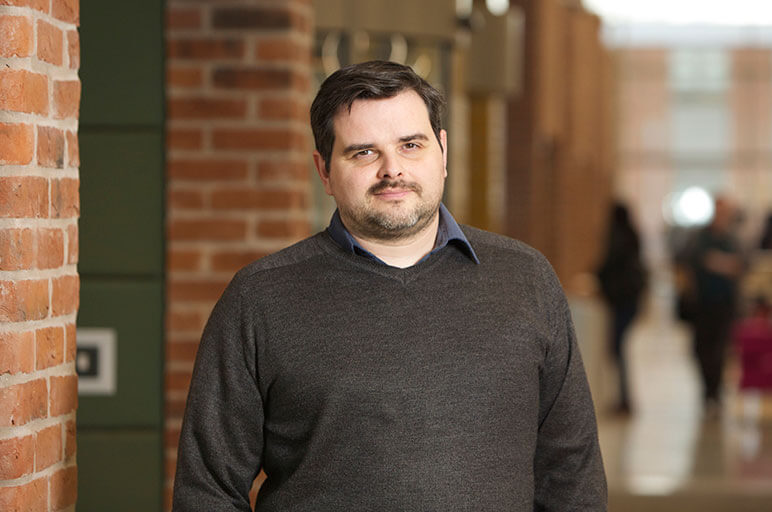Role
Dr Cave teaches on the following modules:
- Inorganic Chemistry
- Skills for Chemistry
- Chemistry of Modern Day Materials
- Advanced Techniques
- Green Chemistry
- Projects
- Research Methodology
- Dissertations
- Metabolomics and Drug Design.
He is also Library Liaison, Disabilities Liaison Tutor and Chemistry Year One course tutor.
Research areas
Dr Cave's main areas of interest are:
- Therapeutic transport devices
- MRI / NMR contrast agents
- Supramolecular chemistry
- Green chemistry - with emphasis on physical-life sciences interface.
Investigations are in three interlinked areas:
Supramolecular chemistry
Utilising non-covalent intermolecular bonding interactions (i.e. hydrogen-bonding, van der Waals forces, coordinate bonds, hydrophobic-hydrophobic, charge transfer interactions, etc.) facilitates the synthesis of large molecular architectures via a self-assembly mechanism. Thereby, enabling the development of discrete nanometre scale molecular capsules and tubes; capable of encapsulating and protecting a variety of guest molecules.
Transport vehicles
The aforementioned supramolecular capsules and tubes are designed with readily accessible surface modifiers incorporated into their structures to allow multi-component functionality (e.g. attachment of hydrophobic / hydrophilic groups, biodegradable linkers, gene and peptide sequence, novel excipients, MRI tracers, pH and UV responsive systems, etc.). The molecular recognition and self-healing properties of these nano-materials allows them to reversibly transport a variety of multi-component guest materials (e.g. drug, gene sequence, peptide, ligand, gases, etc) as "unimolecular micelles" or prodrugs.
Green chemistry
This is the design of chemical products and processes that reduce or eliminate the use and generation of hazardous substances. Conventional methods used throughout organic synthesis involve the use of volatile organic solvents and often have low atom efficiency. Our research in this area looks to benign alternatives to VOC’s (e.g. ionic liquids, supercritical fluids, PPG) or indeed removing solvents altogether.
Other research areas:
- Green chemistry (sustainable technologies)
- MRI contrast agents
- Nanometre scale drug / therapeutic delivery
- Nano partials
- Crystal engineering
- X-Ray crystallography
- Organometallic chemistry
- Supramolecular chemistry
- NMR spectroscopy
- Micro arrays.
Opportunities to carry out postgraduate research towards an MPhil / PhD by research exist in all the areas identified above. Further information may be obtained from the NTU Graduate School.
External activity
- Member of the Institute of Nanotechnology (2004 - present)
- Member of the American Chemical Society (2004 - present)
- Member of the Green Chemistry Network (2001 - present)
- Member of the International Union of Crystallography (2001 - present)
- Member of Chartered Chemist (2000 - present)
- Member of Royal Society of Chemistry (1998 - present)
Sponsors and collaborators
Current and recent research is being carried out with the collaboration, funding and / or support of:
- Engineering and Physical Sciences Research Council
- National Eye Research Centre
- Higher Education Innovation and Regional Fellowships
- Lachesis
- Professor Jerry L Atwood (University of Missouri-Columbia)
- Professor Colin L Raston (University of Western Australia)
- Sir J Fraser Stoddart (University of California, Los Angeles).
Recent projects
- NERC - Research Towards the Next Generation of Immunicological Therapeutic Vaccines and Delivery Systems for the Treatment of Uveal Melanoma
- NTU and EPSRC - Supramolecular Therapeutic Transport Devices
- Lachesis and HIRF - Magnetic Resonance Array System (M-RAY)
- NTU - Templated Nanometre Scale Capsules.
Publications
Selected publications
- Quantification of MRI sensitivity to Quasi-monodisperse microbubble contrast agents for spatially resolved manometry. Bencsik M, Al-Rwaili A, Morris R, Fairhurst DJ, Mundell V, Cave G, McKendry J, Evans S, Magn Reson Med, 2013, 70 (5), 1409-18
- Microwave-assisted synthesis of resorcin[4]arene and pyrogallol[4]arene macrocycles. Cave GWV, Funck M and Guest DP, Tetrahedron Letters, 2010, 51 (49), 6399-6402
- Towards MRI microarrays. Hall A, Mundell VJ, Blanco-Andujar C, Bencsik M, Mchale G, Newton MI, Cave GWV, Chemical Communications, 2010, 46 (14), 2420
- The dynamic chemistry of molecular borromean rings and solomon knots. Meyer CD, Forgan RS, Chichak KS, Peters AJ, Tangchaivang N, Cave GWV, Cantrill SJ, Stoddart JF, Chemistry - A European Journal, 2010, 16 (42), 12570-12581
- Artificial exosomes as tools for basic and clinical immunology. De la Pena H, Madrigal JA, Rusakiewicz S, Bencsik M, Cave GWV, Selman A, Rees R, Travers PJ, Dodi IA, Journal of Immunological Methods, 2009, 344 (2), 121-132
- Molecular borromean rings. Chichak KS, Cantrill SJ, Pease AR, Chiu SH, Cave GWV, Atwood JL, Stoddart JF, Science, 2004, 304, 1308-1310
- Recent advances in solventless organic reactions: towards benign synthesis with remarkable versatility. Cave GWV, Raston CL, Scott JL, Chemical Communications, feature article, 2001, 2159-2169
For full list click 'Go to Gareth Cave's publications' link above.
Press expertise
- Food supplements / fortification
- Drug delivery
- Medical imaging
- Biofuels
- Hydrogen storage
- Lab scale up
- Nanoscience
- Nanotechnology
- Green technologies
UN Sustainable Development Goals
Our research embraces environmentally sustainable approaches to cost-effective high throughput synthetic routes to a range of innovative materials that have found industry applications across seven verticals (i) Healthcare, (ii) Animal Health & Wellbeing, (iii) Agriculture, (iv) Food & Drink, (v) Cosmetics, (vi) Functional Coatings, and (vii) Printable Electronics.



